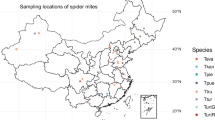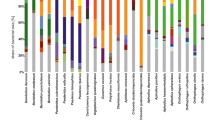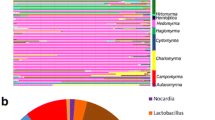Abstract
Bacterial communities in animals are often necessary for hosts to survive, particularly for hosts with nutrient-limited diets. The composition, abundance, and richness of these bacterial communities may be shaped by host identity and external ecological factors. The turtle ants (genus Cephalotes) are predominantly herbivorous and known to rely on bacterial communities to enrich their diet. Cephalotes have a broad Neotropical distribution, with high diversity in the South American Cerrado, a geologically and biologically diverse savanna. Using 16S rRNA amplicon sequencing, we examined the bacterial communities of forty-one Cephalotes samples of sixteen different species collected from multiple locations across two sites in the Cerrado (MG, Brazil) and compared the bacterial communities according to elevation, locality, species, and species group, defined by host phylogeny. Beta diversity of bacterial communities differed with respect to all categories but particularly strongly when compared by geographic location, species, and species group. Differences seen in species and species groups can be partially explained by the high abundance of Mesorhizobium in Cephalotes pusillus and Cephalotes depressus species groups, when compared to other clades via the Analysis of Composition of Microbiome (ANCOM). Though the Cephalotes bacterial community is highly conserved, results from this study indicate that multiple external factors can affect and change bacterial community composition and abundance.






Similar content being viewed by others
Data Availability
All raw sequence data are publicly available in the NCBI SRA accession number PRJNA859790 and BioSample SUB11807550
References
Anderson MJ (2001) A new method for non-parametric multivariate analysis of variance. Austral Ecol 26:32–46. https://doi.org/10.1111/j.1442-9993.2001.01070.pp.x
Apprill A, McNally S, Parsons R, Weber L (2015) Minor revision to V4 region SSU rRNA 806R gene primer greatly increases detection of SAR11 bacterioplankton. Aquat Microb Ecol 75(2):129–137. https://doi.org/10.3354/ame01753
Birer C, Moreau CS, Tysklind N, Zinger L, Duplais C (2020) Disentangling the assembly mechanisms of ant cuticular bacterial communities of two Amazonian ant species sharing a common arboreal nest. Mol Ecol 29(7):1372–1385. https://doi.org/10.1111/mec.15400
Bolyen E, Rideout JR, Dillon MR et al (2019) Reproducible, interactive, scalable and extensible microbiome data science using QIIME 2. Nat Biotechnol 37:852–857. https://doi.org/10.1038/s41587-019-0209-9
Brandao CRF, Feitosa RM, Powell S, Del-Claro K (2014) Description of Cephalotes specularis n. sp.(Formicidae: Myrmicinae)—the mirror turtle ant. Zootaxa 3796(3):568–578
Brown JJ, Jandová A, Jeffs CT, Higgie M, Nováková E, Lewis OT, Hrček J (2021) Microbiome structure of a wild Drosophila community along tropical elevational gradients and comparison to laboratory lines. bioRxiv. https://doi.org/10.1101/2021.07.28.454263
Callahan BJ, McMurdie PJ, Rosen MJ, Han AW, Johnson AJA, Holmes SP (2016) DADA2: high-resolution sample inference from Illumina amplicon data. Nat Methods 13(7):581–583. https://doi.org/10.1038/nmeth.3869
Caporaso JG, Lauber CL, Walters WA, Berg-Lyons D, Huntley J, Fierer N, Owens SM, Betley J, Fraser L, Bauer M (2012) Ultra-high-throughput microbial community analysis on the Illumina HiSeq and MiSeq platforms. ISME J 6(8):1621–1624. https://doi.org/10.1038/ismej.2012.8
Cardoso Da Silva JM, Bates JM (2002) Biogeographic patterns and conservation in the South American Cerrado: a tropical savanna hotspot: the Cerrado, which includes both forest and savanna habitats, is the second largest South American biome, and among the most threatened on the continent. BioScience 52(3):225–234. https://doi.org/10.1641/0006-3568(2002)052[0225:Bpacit]2.0.Co;2
Chanson A, Moreau CS, Duplais C (2021) Assessing biosynthetic gene cluster diversity of specialized metabolites in the conserved gut symbionts of herbivorous turtle ants. Front Microbiol 12:678100. https://doi.org/10.3389/fmicb.2021.678100
Corn ML (1976) The ecology and behavior of Cephalotes atratus, a Neotropical ant (Hymenoptera: Formicidae) (Order No. 7722838). Available from ProQuest Dissertations & Theses Global. (302794335). Retrieved from https://www.proquest.com/dissertations-theses/ecology-behavior-cephalotes-atratus-neotropical/docview/302794335/se-2?accountid=10267
Cuesta EB, Coulibaly B, Bukhari T, Eiglmeier K, Kone R, Coulibaly MB, Zongo S, Barry M, Gneme A, Guelbeogo WM, Beavogui AH, Traore SF, Sagnon NF, Vernick KD, Riehle MM (2021) Comprehensive ecological and geographic characterization of eukaryotic and prokaryotic microbiomes in African Anopheles. Front Microbiol 12:635772. https://doi.org/10.3389/fmicb.2021.635772
Davis NM, Proctor DM, Holmes SP, Relman DA, Callahan BJ (2018) Simple statistical identification and removal of contaminant sequences in marker-gene and metagenomics data. Microbiome 6(1):1–14. https://doi.org/10.1186/s40168-018-0605-2
De Andrade ML, Urbani CB (1999) Diversity and adaptation in the ant genus Cephalotes, past and present. Staatliches Museum für Naturkunde
Fernandes GW (2016) The Megadiverse Rupestrian Grassland. In: Fernandes G (eds) Ecology and Conservation of Mountaintop grasslands in Brazil. Springer, Cham, pp 3–14. https://doi.org/10.1007/978-3-319-29808-5_1
Flynn PJ, D’Amelio CL, Sanders JG, Russell JA, Moreau CS, Liu S-J (2021) Localization of bacterial communities within gut compartments across Cephalotes turtle ants. Appl Environ Microbiol 87(8):e02803–e02820. https://doi.org/10.1128/AEM.02803-20
Graber LC, Fallon AM (2019) Tetracycline reduces feeding and reproduction of the parthenogenetic springtail, Folsomia candida. Symbiosis 77(3):257–264. https://doi.org/10.1007/s13199-018-00593-0
Hongoh Y, Deevong P, Inoue T, Moriya S, Trakulnaleamsai S, Ohkuma M, Vongkaluang C, Noparatnaraporn N, Kudo T (2005) Intra-and interspecific comparisons of bacterial diversity and community structure support coevolution of gut microbiota and termite host. Appl Environ Microbiol 71(11):6590–6599. https://doi.org/10.1128/AEM.71.11.6590-6599.2005
Hu Y, D’Amelio CL, Béchade B, Cabuslay CS, Sanders JG, Price S, Fanwick E, Powell S, Moreau CS, Russell JA (2021) The secrets to domestic bliss – partner fidelity and environmental filtering preserve stage-specific turtle ant gut symbioses for over 40 million years. Cold Spring Harbor Lab. https://doi.org/10.1101/2021.09.13.460005
Hu Y, Łukasik P, Moreau CS, Russell JA (2014) Correlates of gut community composition across an ant species (Cephalotes varians) elucidate causes and consequences of symbiotic variability. Mol Ecol 23(6):1284–1300. https://doi.org/10.1111/mec.12607
Hu Y, Sanders JG, Łukasik P, D’Amelio CL, Millar JS, Vann DR, Lan Y, Newton JA, Schotanus M, Kronauer DJC, Pierce NE, Moreau CS, Wertz JT, Engel P, Russell JA (2018) Herbivorous turtle ants obtain essential nutrients from a conserved nitrogen-recycling gut microbiome. Nat Commun 9(1):964. https://doi.org/10.1038/s41467-018-03357-y
Hughey MC, Pena JA, Reyes R, Medina D, Belden LK, Burrowes PA (2017) Skin bacterial microbiome of a generalist Puerto Rican frog varies along elevation and land use gradients. PeerJ 5:e3688. https://doi.org/10.7717/peerj.3688
Ishak HD, Plowes R, Sen R, Kellner K, Meyer E, Estrada DA, Dowd SE, Mueller UG (2011) Bacterial diversity in Solenopsis invicta and Solenopsis geminata ant colonies characterized by 16S amplicon 454 pyrosequencing. Microb Ecol 61(4):821–831. https://doi.org/10.1007/s00248-010-9793-4
Kelly M, Price SL, de Oliveira Ramalho M, Moreau CS (2019) Diversity of Wolbachia associated with the giant turtle ant, Cephalotes atratus. Curr Microbiol 76(11):1330–1337. https://doi.org/10.1007/s00284-019-01722-8
Kruskal WH, Wallis WA (1952) Use of ranks in one-criterion variance analysis. J Am Stat Assoc 47(260):583–621
Lewis Z, Lizé A (2015) Insect behaviour and the microbiome. Curr Opin Insect Sci 9:86–90. https://doi.org/10.1016/j.cois.2015.03.003
Li H, Wang Y, Yu Q, Feng T, Zhou R, Shao L, Qu J, Li N, Bo T, Zhou H (2019) Elevation is associated with human skin microbiomes. Microorganisms 7(12):611. https://doi.org/10.3390/microorganisms7120611
Lin JY, Hobson WJ, Wertz JT (2016) Ventosimonas gracilis gen. nov., sp. nov., a member of the Gammaproteobacteria isolated from Cephalotes varians ant guts representing a new family, Ventosimonadaceae fam. nov., within the order ‘Pseudomonadales’. Int J Syst Evol Microbiol 66(8):2869–2875. https://doi.org/10.1099/ijsem.0.001068
Lomolino MV (2001) Elevation gradients of species-density: historical and prospective views. Glob Ecol Biogeogr 10(1):3–13. https://doi.org/10.1046/j.1466-822x.2001.00229.x
Mandal S, Van Treuren W, White RA, Eggesbø M, Knight R, Peddada SD (2015) Analysis of composition of microbiomes: a novel method for studying microbial composition. Microb Ecol Health Dis 26(1):27663. https://doi.org/10.3402/mehd.v26.27663
Martins C, Moreau CS (2020) Influence of host phylogeny, geographical location and seed harvesting diet on the bacterial community of globally distributed Pheidole ants. PeerJ 8:e8492. https://doi.org/10.7717/peerj.8492
Martinson VG, Moy J, Moran NA (2012) Establishment of characteristic gut bacteria during development of the honeybee worker. Appl Environ Microbiol 78(8):2830–2840. https://doi.org/10.1128/AEM.07810-11
Mayr AV, Keller A, Peters MK, Grimmer G, Krischke B, Geyer M, Schmitt T, Steffan-Dewenter I (2021) Cryptic species and hidden ecological interactions of halictine bees along an elevational gradient. Ecol Evol 11(12):7700–7712. https://doi.org/10.1002/ece3.7605
McMurdie PJ, Holmes S (2013) phyloseq: an R package for reproducible interactive analysis and graphics of microbiome census data. PLoS One 8(4):e61217. https://doi.org/10.1371/journal.pone.0061217
Mirarab S, Nguyen N, Warnow T (2012) SEPP: SATé-enabled phylogenetic placement. Biocomputing 2012. World Scientific, pp 247–258
Montoya-Ciriaco N, Gómez-Acata S, Muñoz-Arenas LC, Dendooven L, Estrada-Torres A, Díaz De La Vega-Pérez AH, Navarro-Noya YE (2020) Dietary effects on gut microbiota of the mesquite lizard Sceloporus grammicus (Wiegmann, 1828) across different altitudes. Microbiome 8(1):6. https://doi.org/10.1186/s40168-020-0783-6
Moreau CS (2014) A practical guide to DNA extraction, PCR, and gene-based DNA sequencing in insects. Halteres 5:32–42
Moreau CS (2020) Symbioses among ants and microbes. Curr Opin Insect Sci 39:1–5. https://doi.org/10.1016/j.cois.2020.01.002
Morellato LPC, Silveira FAO (2018) Plant life in campo rupestre : new lessons from an ancient biodiversity hotspot. Flora 238:1–10. https://doi.org/10.1016/j.flora.2017.12.001
Oksanen J, Simpson G, Blanchet F, Kindt R, Legendre P, Minchin P, O'Hara R, Solymos P, Stevens M, Szoecs E, Wagner H, Barbour M, Bedward M, Bolker B, Borcard D, Carvalho G, Chirico M, De Caceres M, Durand S et al (2022) vegan: community ecology package. R package version 2:6–2 https://CRAN.R-project.org/package=vegan
Oliveira AM, Powell S, Feitosa RM (2021) A taxonomic study of the Brazilian turtle ants (Formicidae: Myrmicinae: Cephalotes). Revista Brasileira de Entomologia 65(3):1–52. https://doi.org/10.1590/1806-9665-rbent-2021-0028
Parada AE, Needham DM, Fuhrman JA (2016) Every base matters: assessing small subunit rRNA primers for marine microbiomes with mock communities, time series and global field samples. Environ Microbiol 18(5):1403–1414. https://doi.org/10.1111/1462-2920.13023
Powell S (2008) Ecological specialization and the evolution of a specialized caste in Cephalotes ants. Funct Ecol 22(5):902–911. https://doi.org/10.1111/j.1365-2435.2008.01436.x
Powell S (2016) A comparative perspective on the ecology of morphological diversification in complex societies: nesting ecology and soldier evolution in the turtle ants. Behav Ecol Sociobiol 70:1075–1085. https://doi.org/10.1007/s00265-016-2080-8
Price SL, Blanchard BD, Powell S, Blaimer BB, Moreau CS (2022) Phylogenomics and fossil data inform the systematics and geographic range evolution of a diverse Neotropical ant lineage. Insect Syst Diversity 6(1). https://doi.org/10.1093/isd/ixab023
Price SL, Etienne RS, Powell S (2016) Tightly congruent bursts of lineage and phenotypic diversification identified in a continental ant radiation. Evolution 70(4):903–912. https://doi.org/10.1111/evo.12894
Price SL, Powell S, Kronauer DJC, Tran LAP, Pierce NE, Wayne RK (2014) Renewed diversification is associated with new ecological opportunity in the Neotropical turtle ants. J Evol Biol 27(2):242–258. https://doi.org/10.1111/jeb.12300
Procópio L, Barreto C (2021) The soil microbiomes of the Brazilian Cerrado. J Soils Sediments 21(6):2327–2342. https://doi.org/10.1007/s11368-021-02936-9
Quast C, Pruesse E, Yilmaz P, Gerken J, Schweer T, Yarza P, Peplies J, Glöckner FO (2012) The SILVA ribosomal RNA gene database project: improved data processing and web-based tools. Nucleic Acids Res 41(D1):D590–D596. https://doi.org/10.1093/nar/gks1219
Ramalho MO, Bueno OC, Moreau CS (2017a) Microbial composition of spiny ants (Hymenoptera: Formicidae: Polyrhachis) across their geographic range. BMC Evol Biol 17(1):96. https://doi.org/10.1186/s12862-017-0945-8
Ramalho MO, Bueno OC, Moreau CS (2017b) Species-specific signatures of the microbiome from Camponotus and Colobopsis ants across developmental stages. PLoS One 12(11):e0187461. https://doi.org/10.1371/journal.pone.0187461
Ramalho MO, Duplais C, Orivel J, Dejean A, Gibson JC, Suarez AV, Moreau CS (2020) Development but not diet alters microbial communities in the Neotropical arboreal trap jaw ant Daceton armigerum: An exploratory study. Sci Rep 10(1):1–12. https://doi.org/10.1038/s41598-020-64393-7
Ramalho MO, Moreau CS, Bueno OC (2019) The potential role of environment in structuring the microbiota of Camponotus across parts of the body. Adv Entomol 7(3):47–70. https://doi.org/10.4236/ae.2019.73005
Ratter JA, Ribeiro JF, Bridgewater S (1997) The Brazilian Cerrado vegetation and threats to its biodiversity. Ann Bot 80(3):223–230. https://doi.org/10.1006/anbo.1997.0469
Russell JA, Moreau CS, Goldman-Huertas B, Fujiwara M, Lohman DJ, Pierce NE (2009) Bacterial gut symbionts are tightly linked with the evolution of herbivory in ants. Proc Natl Acad Sci 106(50):21236–21241. https://doi.org/10.1073/pnas.0907926106
Sanders JG, Powell S, Kronauer DJ, Vasconcelos HL, Frederickson ME, Pierce NE (2014) Stability and phylogenetic correlation in gut microbiota: lessons from ants and apes. Mol Ecol 23(6):1268–1283. https://doi.org/10.1111/mec.12611
Shen C, Xiong J, Zhang H, Feng Y, Lin X, Li X, Liang W, Chu H (2013) Soil pH drives the spatial distribution of bacterial communities along elevation on Changbai Mountain. Soil Biol Biochem 57:204–211. https://doi.org/10.1016/j.soilbio.2012.07.013
Silva JD (1995) Birds of the cerrado region, South America. Steenstrupia 21(1):69–92
Simon MF, Grether R, De Queiroz LP, Skema C, Pennington RT, Hughes CE (2009) Recent assembly of the Cerrado, a neotropical plant diversity hotspot, by in situ evolution of adaptations to fire. Proc Natl Acad Sci U S A 106(48):20359–20364. https://doi.org/10.1073/pnas.0903410106
Sudhagar S, Reddy PR, Nagalakshmi G (2017) Influence of elevation in structuring the gut bacterial communities of Apis cerana. J Entomol Zool Stud 5:434–440 http://krishi.icar.gov.in/jspui/handle/123456789/17490
Welch EW, Macias J, Bextine B (2015) Geographic patterns in the bacterial microbiome of the glassy-winged sharpshooter, Homalodisca vitripennis (Hemiptera: Cicadellidae). Symbiosis 66(1):1–12. https://doi.org/10.1007/s13199-015-0332-4
Acknowledgements
We thank Heraldo Vasconcelos, Frederico de Siqueira Neves, and Geraldo Wilson Fernandes for arranging access to field sites. LCG thanks Jon Sanders for helping with QIIME2. SP thanks Flávio Camarota, Shauna Price, Jignasha Rana, and Carol Pertetz for helping in the field. Samples were collected on private land with the land owner’s permission.
Funding
This project was supported by grants to SP (NSF DEB 1442256) and CSM (NSF DEB 1900357).
Author information
Authors and Affiliations
Contributions
All authors contributed to developing the overarching project ideas, while LCG and MOR developed the hypotheses tested in the study and led the research. MOR performed DNA extractions and 16S rRNA library prep. LCG did analyses, wrote the manuscript, and made all figures, tables, and supplementary materials. SP collected and provided ant specimens. All authors discussed and contributed to the final manuscript.
Corresponding author
Ethics declarations
Competing Interests
The authors declare no competing interests.
Supplementary Information
Supplementary Material 1:
List of forty-one Cephalotes samples included in this study. Includes collection information, designation in location and elevational categories, species, and species group. (XLSX 14 kb)

Supplementary Material 2:
Alpha-rarefaction plot with samples represented by individual lines. The sampling depth is shown on the x-axis. (PNG 197 kb)
Supplementary Material 3:
List of all ASVs identified by 16S rRNA amplicon sequencing in complete bacterial communities. Samples are labelled by collection code and species. (XLSX 25 kb)
Supplementary Material 4:
List of all ASVs identified by 16S rRNA amplicon sequencing in ‘core’ bacterial communities (bacteria found in >50% of samples). (XLSX 10 kb)
Supplementary Material 5:
Pairwise Alpha diversity (Faith’s and Shannon) in complete bacterial communities. (XLSX 14 kb)
Supplementary Material 6:
Pairwise Alpha diversity (Faith’s and Shannon) in ‘core’ bacterial communities. (XLSX 14 kb)
Supplementary Material 7:
Pairwise Beta diversity (Bray-Curtis and Jaccard) in complete bacterial communities. (XLSX 9 kb)
Supplementary Material 8:
Pairwise Beta diversity (Bray-Curtis and Jaccard) in ‘core’ bacterial communities. (XLSX 9 kb)
Rights and permissions
Springer Nature or its licensor (e.g. a society or other partner) holds exclusive rights to this article under a publishing agreement with the author(s) or other rightsholder(s); author self-archiving of the accepted manuscript version of this article is solely governed by the terms of such publishing agreement and applicable law.
About this article
Cite this article
Graber, L.C., Ramalho, M.O., Powell, S. et al. Identifying the Role of Elevation, Geography, and Species Identity in Structuring Turtle Ant (Cephalotes Latreille, 1802) Bacterial Communities. Microb Ecol 86, 1240–1253 (2023). https://doi.org/10.1007/s00248-022-02128-z
Received:
Accepted:
Published:
Issue Date:
DOI: https://doi.org/10.1007/s00248-022-02128-z




